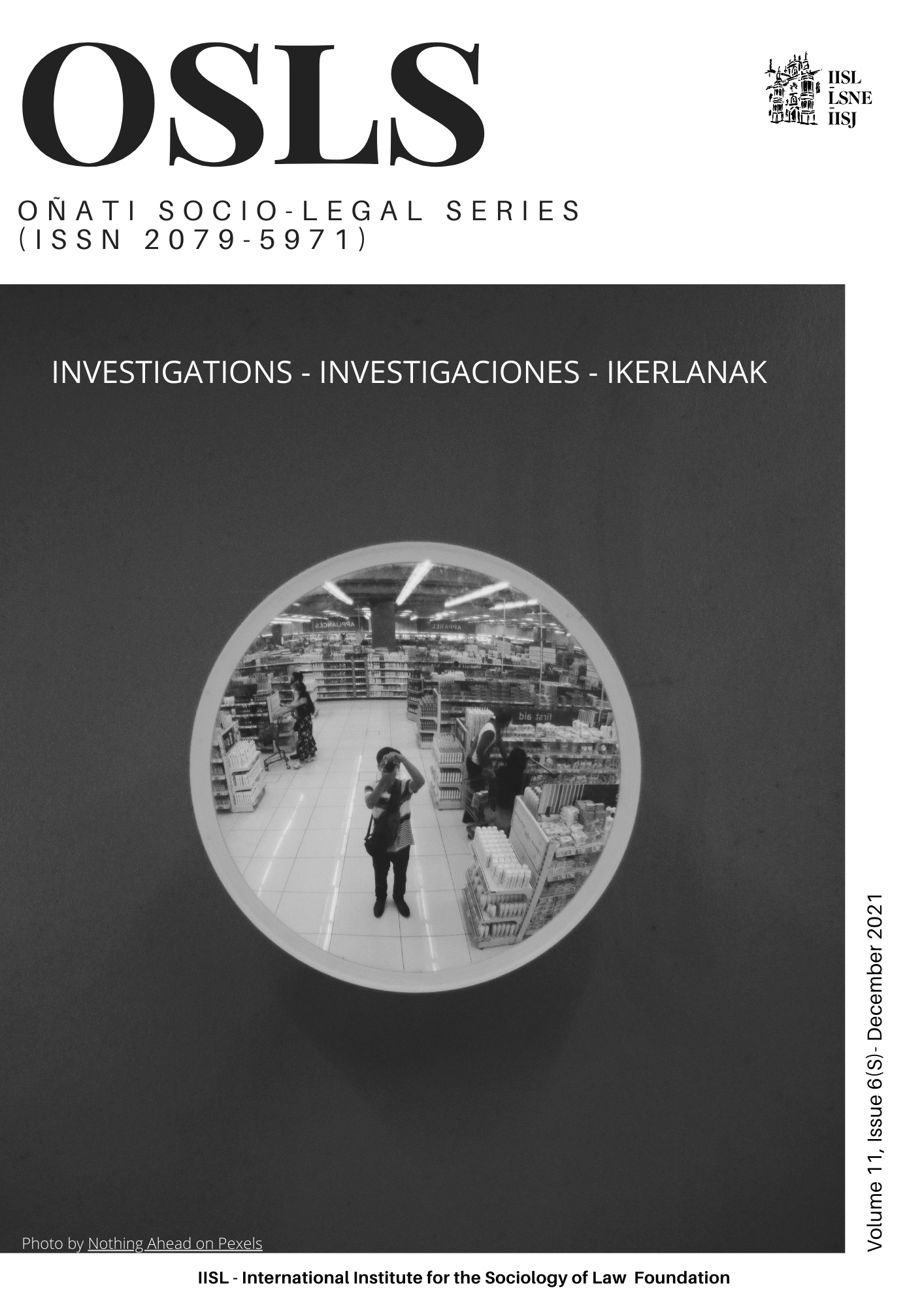The courtroom as a built environment
On the usefulness of Amos Rapoport’s theoretical framework
DOI:
https://doi.org/10.35295/osls.iisl/0000-0000-0000-1230Palabras clave:
Amos Rapoport, arquitectura del tribunal, comunicación en el tribunal, estudio del comportamiento ambientalResumen
Amos Rapoport es uno de los pioneros del estudio de las relaciones entre las personas y sus entornos. Al mismo tiempo, el análisis del entorno construido como un factor codeterminante de las interacciones humanas en el tribunal es cada vez más popular en la literatura. Siguiendo esa línea, el artículo se propone considerar si el marco teórico de Rapoport (especialmente la parte relacionada con la comunicación no verbal a través del entorno) podría ser aplicado de forma fructífera al estudio del tribunal, especialmente para arrojar luz sobre los aspectos espaciales, físicos o arquitectónicos del tribunal (el cual se trata como un entorno especial). El artículo ofrece un examen inicial, preliminar, sobre la utilidad del marco de Rapoport en referencia al interior del juzgado. Hay que subrayar que los autores intentan examinar la aplicabilidad general del marco de Rapoport, en lugar de centrarse en una jurisdicción concreta como punto de referencia.
Descargas
Metrics
Estadísticas globales ℹ️
|
1293
Visualizaciones
|
2743
Descargas
|
|
4036
Total
|
|
Citas
Altman, I., 2000. Amos Rapoport: Scholar, Conscience and Citizen of the Environment and Behaviour Field. In: K.D. Moore, ed., Culture-meaning-architecture: Critical Reflections on the Work of Amos Rapoport. London: Routledge.
Austin, W.T., 1982. Portrait of a Courtroom Social and Ecological Impressions of the Adversary Process. Criminal Justice and Behavior [online], 9(3), 286–302. Available from: https://doi.org/10.1177/0093854882009003003 [Access 20 September 2021]. DOI: https://doi.org/10.1177/0093854882009003003
Barshack, L., 2010. The Constituent Power of Architecture. Law, Culture, and the Humanities [online], 7(2), 217–243. Available from: https://doi.org/10.1177/1743872109355549 [Access 20 September 2021]. DOI: https://doi.org/10.1177/1743872109355549
Bradley, R.V.V., 1970. A Critical Analysis of the Writings of Amos Rapoport. Journal of Architectural Education [online], 24(2/3), 16–25. Available from: https://doi.org/10.1080/10464883.1970.11102460 [Access 20 September 2021]. DOI: https://doi.org/10.1080/10464883.1970.11102460
Branco, P., 2016. Courthouses as Spaces of Recognition, Functionality and Access to Law and Justice: A Portuguese Reflection. Oñati Socio-Legal Series [online], 6(3), 426–441. Available from: https://opo.iisj.net/index.php/osls/article/view/497 [Access 20 September 2021].
Branco, P., 2018. Considering a Different Model for the Family and Children Courthouse Building. Reflections on the Portuguese Experience. Oñati Socio-Legal Series [online], 8(3), 400–418. Available from: https://doi.org/10.35295/osls.iisl/0000-0000-0000-0940 [Access 20 September 2021]. DOI: https://doi.org/10.35295/osls.iisl/0000-0000-0000-0940
Cobley, O., and Schulz, P.J., eds., 2013. Theories and Models of Communication. Mouton: De Gruyter. DOI: https://doi.org/10.1515/9783110240450
Collins, C.S., and Stockton, C.M., 2018. The Central Role of Theory in Qualitative Research. International Journal of Qualitative Methods [online], 17, 1–20. Available from: https://doi.org/10.1177/1609406918797475 [Access 20 September 2021]. DOI: https://doi.org/10.1177/1609406918797475
Dahlberg, L., 2016. Spacing Law and Politics: The Constitution and Representation of the Juridical. London: Routledge. DOI: https://doi.org/10.4324/9781315680224
DesBaillets, D., 2018. Representing Canadian Justice: Legal Iconography and Symbolism at the Supreme Court of Canada. International Journal of Law in Context [online], 14(1), 132–156. Available from: https://doi.org/10.1017/S1744552317000180 [Access 20 September 2021]. DOI: https://doi.org/10.1017/S1744552317000180
Doerksen, L.E., 1989-90. Out of the Dock and Into the Bar: An Examination of the History and Use of the Prisoner’s Dock. Criminal Law Quarterly, 32, 478–502.
Epstein, B., 2018. Social Ontology. In: N. Zalta, ed., The Stanford Encyclopedia of Philosophy [online]. Metaphysics Research Lab, Center for the Study of Language and Information, Stanford University. Available from: https://plato.stanford.edu/archives/sum2018/entries/social-ontology/ [Access 29 January 2021].
Fox, J.R., 2014. Visual Art in American Courthouses. In: A. Wagner, R.K. Scherin, eds., Law, Culture and Visual Studies. Cham: Springer. DOI: https://doi.org/10.1007/978-90-481-9322-6_27
Gélinas, F., et al., 2015. Foundations of Civil Justice: Toward a Value-Based Framework for Reform. Cham: Springer. DOI: https://doi.org/10.1007/978-3-319-18775-4
Greenberg, A., 1987. Symbolism in Architecture: Courtrooms. In: N. Glazer, M. Lilla, eds, The Public Face of Architecture: Civic Culture and Public Spaces. New York: Free Press.
Hall, E.T., 1966. The Hidden Dimension. New York: Doubleday.
Hazard, J.N., 1962. Furniture Arrangement as a Symbol of Judicial Roles. ETC: A Review of General Semantics, 19(2), 181–188.
Heidari, A.A, Hoseini, P.M., and Behdadfa, N., 2014. Reading a Home: An Application of Rapoport's Viewpoint in Iranian Architecture Studies. International Journal of Architecture and Urban Development [online], 4(1), 63–74. Available from: https://ijaud.srbiau.ac.ir/article_2500.html [Access 20 September 2021].
Jeffrey, A., 2019. Legal Geography 1: Court Materiality. Progress in Human Geography [online], 43(3), 565–573. Available from: https://doi.org/10.1177/0309132517747746 [Access 20 September 2021]. DOI: https://doi.org/10.1177/0309132517747746
Latour, B., 2005. Reassembling the Social: An Introduction to Actor-Network-Theory. New York: Oxford University Press. DOI: https://doi.org/10.1093/oso/9780199256044.001.0001
Law-Viljoen, B., ed., 2006. Light on a Hill: Building the Constitutional Court of South Africa. Parkwood: David Krut.
Levine, S.J., 1997. Religious Symbols and Religious Garb in the Courtroom: Personal Values and Public Judgments. Fordham Law Review, 66(4), 1505–1540.
Marks, A., et al., 2016. What is a Court? A Report by JUSTICE [online]. London. Available from: https://files.justice.org.uk/wp-content/uploads/2016/05/06170726/JUSTICE-What-is-a-Court-Report-2016.pdf [Access 20 September 2021].
McGee, K., 2014. Bruno Latour: The Normativity of Networks. Abingdon: Routledge.
McGee, K., ed., 2015. Latour and the Passage of Law. Edinburgh University Press. DOI: https://doi.org/10.3366/edinburgh/9780748697908.001.0001
McKimmie, B.M., Hays, J.M. and Tait, D., 2016. Just Spaces: Does Courtroom Design Affect How the Defendant is Perceived? Psychiatry, Psychology and Law [online], 23(6), 885–892. Available from: https://doi.org/10.1080/13218719.2016.1174054 [Access 20 September 2021]. DOI: https://doi.org/10.1080/13218719.2016.1174054
Moore, K.D., ed., 2000. Culture-Meaning-Architecture. Critical Reflections on the Work of Amos Rapoport. Aldershot: Ashgate.
Mulcahy, L., 2007. Architects of Justice: The Politics of Courtroom Design. Social and Legal Studies, 16(3), 383–403. DOI: https://doi.org/10.1177/0964663907079765
Mulcahy, L., 2011. Legal Architecture: Justice, Due Process and the Place of Law. Abingdon: Routledge.
Mulcahy, L., 2013. Putting the Defendant in Their Place: Why Do We Still Use the Dock in Criminal Proceedings? British Journal of Criminology [online], 53(6), 1139–1156. Available from: https://doi.org/10.1093/bjc/azt037 [Access 20 September 2021]. DOI: https://doi.org/10.1093/bjc/azt037
Mulcahy, L., and Rowden, E., 2019. The Democratic Courthouse. London: Routledge. DOI: https://doi.org/10.4324/9780429263651
Rapoport, A., 1990. The Meaning of the Built Environment: A Nonverbal Communication Approach. Tucson: University of Arizona Press.
Rapoport, A., 1994. Spatial Organization and the Built Environment. In: T. Ingold, ed., Companion Encyclopedia of Anthropology: Humanity, Culture and Social Life. London: Routledge.
Rapoport, A., 1997. Theory in Environment-Behavior Studies: Transcending Tunes, Settings, and Groups. In: S. Wapner et al., eds., Handbook of Japan-United States Environment-Behavior Research: Toward a Transactional Approach. New York: Plenum Press. DOI: https://doi.org/10.1007/978-1-4899-0286-3_28
Rapoport, A., 2000. Science, Explanatory Theory, and Environment-Behavior Studies. In: S. Wapner et al., eds., Theoretical Perspectives in Environment-Behavior Research. Underlying Assumptions, Research Problems, and Methodologies. New York: Plenum Press.
Rapoport, A., 2005. Culture, Architecture, and Design. Chicago: Locke Science.
Rapoport, A., 2008a. Environment-Behaviour Studies: Past, Present, and Future. Journal of Architectural and Planning Research, 4, 267–281.
Rapoport, A., 2008b. Some Further Thoughts on Culture and Environment. ArchNet-IJAR: International Journal of Architectural Research, 2(1), 16–39.
Resnik, J., and Curtis, D., 2011. Representing Justice: Invention, Controversy, and Rights in City-states and Democratic Courtrooms. New Haven: Yale University Press.
Resnik, J., Curtis, D., and Tait, J., 2014. Constructing Courts: Architecture, the Ideology of Judging, and the Public Sphere. In: K. Sherwin and A. Wagner, eds., Law, Culture & Visual Studies, Berlin: Springer. DOI: https://doi.org/10.2139/ssrn.2447895
Richardson, C., 2008. Symbolism in the Courtroom: An Examination of the Influence of Non-verbal Cues in a District Court Setting on Juror Ability to Focus on the Evidence. Saarbrücken: VDM.
Rock, P., 1991. Witnesses and Space in a Crown Court. British Journal of Criminology, 31(3), 266–279. DOI: https://doi.org/10.1093/oxfordjournals.bjc.a048116
Rosenbloom, J.D., 1998. Social Ideology as Seen Through Courtroom and Courthouse Architecture. Columbia Journal of Law & the Arts [online], 22(463), 463–523. Available from: https://ssrn.com/abstract=1445952 [Access 11 October 2021].
Rossner, M., et al., 2017. The Dock on Trial: Courtroom Design and the Presumption of Innocence. Journal of Law and Society, 44(3), 317–344. DOI: https://doi.org/10.1111/jols.12033
Shakouri, R., and Namdari, A., 2018. Study of the Mechanism for Organizing the Environment with the Minimum Physical Elements (Through the lens of Amos Rapoport Theory: Organization of Environment) (Case study: Qashqai Nomad’s Dwelling). The Monthly Scientific Journal of Bagh-e Nazar [online], 15(67), 5–16. Available from: https://dx.doi.org/10.22034/bagh.2018.80610 [Access 20 September 2021].
Shepard, S., 2006. Should the Criminal Defendant Be Assigned a Seat in Court? The Yale Law Journal, 115(8), 2203–2210. https://doi.org/10.2307/20455689 [Access 20 September 2021]. DOI: https://doi.org/10.2307/20455689
Spaulding, N.W., 2012. The Enclosure of Justice: Courthouse Architecture, Due Process, and the Dead Metaphor of Trial. Yale Journal of Law & the Humanities [online], 24(1), 311–343. Available from: https://digitalcommons.law.yale.edu/yjlh/vol24/iss1/16/ [Access 20 September 2021].
Tait, D., 2011. Glass Cages in the Dock?: Presenting the Defendant to the Jury. Chicago-Kent Law Review [online], 86(2), 467–495. Available from: https://scholarship.kentlaw.iit.edu/cklawreview/vol86/iss2/4 [Access 20 September 2021].
Wendland, M., 2013. Controversy Over the Status of the Communication Transmission Models. Dialogue and Universalism, 23(1), 51–63. DOI: https://doi.org/10.5840/du201323119
Wolfe, J.S., 1994. The Effect of Location in the Courtroom on Jury Perception of Lawyer Performance. Pepperdine Law Review [online], 21(3), 731–776. Available from: https://digitalcommons.pepperdine.edu/plr/vol21/iss3/2 [Access 20 September 2021].
Wolfe, J.S., 1995. Toward a Unified Theory of Courtroom Design Criteria: The Effect of Courtroom Design on Adversarial Interaction. American Journal of Trial Advocacy, 18(3), 593–656.
Yablon, C.M., 1995. Judicial Drag: An Essay on Wigs, Robes and Legal Change. Wisconsin Law Review, 5, 1129–1153.
Publicado
Cómo citar
Número
Sección
Licencia
Derechos de autor 2021 Mateusz Stępień, Michał Dudek

Esta obra está bajo una licencia internacional Creative Commons Atribución-NoComercial-SinDerivadas 4.0.
Los autores conservan el copyright de sus trabajos, que se publicarán en OSLS bajo una licencia Creative Commons Reconocimiento NoComercial SinObraDerivada. Puede consultar más detalles en: http://es.creativecommons.org/licencia/. Si no está de acuerdo con esta licencia, por favor, póngase en contacto con nosotros.
El autor concede los permisos necesarios para difundir la información bibliográfica del artículo, incluyendo el resumen, y autorizar a otros, incluyendo las bases de datos bibliográficas, de índices y servicios de alerta de contenidos, a copiar y comunicar esta información.
Para más información sobre los permisos para distribuir su artículo en cada fase de la producción, por favor, lea nuestra Política de Autoarchivo y Divulgación (en inglés).
Las condiciones de copyright con el nombre de autores y co-autores, y la licencia Creative Commons se mostrarán en el artículo. Estas condiciones se deben aceptar como parte del proceso de envío de un artículo a la revista. Por favor, asegúrese de que todos los co-autores se mencionan correctamente, y que entienden y aceptan estos términos.






















